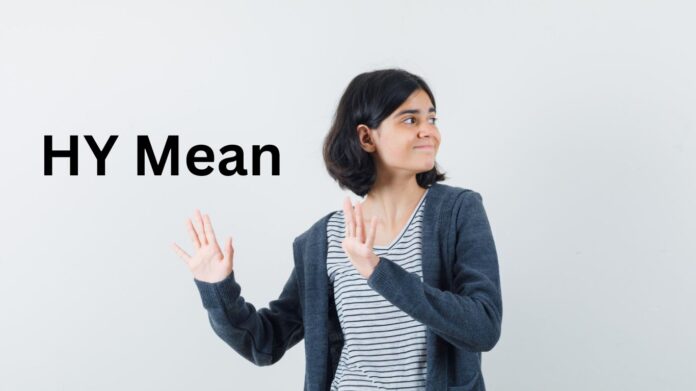Texting and talking to people online have changed the way we talk to each other in today’s fast-paced digital world.
Out of all the acronyms and abbreviations that have come up, “HY” is one of the most useful and widely used ones in today’s texting society.
Understanding what HY means and how to use it correctly can greatly improve your digital communication skills, whether you’re scrolling through social media, answering a quick text, or having a casual chat online.
What Does HY Signify?
Depending on the situation, the word “HY” can mean more than one thing. For digital conversation to work, you need to understand these different meanings. Most people know that HY can mean one of two things:
HY as “Hell Yes”: This meaning means enthusiasm, strong agreement, or pleasure about something. When someone uses HY in this way, they’re saying in a short, powerful way that they strongly agree or are very happy with something. It’s the same thing as yelling “absolutely!” or “definitely!” with real excitement.
When used as “Hi You,” HY is a relaxed, friendly way to say hello. It’s a casual way to let someone know you’re there or start a chat. People who like to talk to their friends, family, and close acquaintances in a casual, conversational way tend to support this interpretation.
These are the main meanings of HY, but the exact meaning relies on the situation, the people involved, and the overall tone of the conversation.
How do you use HY when you text?
Because HY is flexible, it can be used in a wide range of texting situations and conversation styles. The way people use it has changed over time to meet the needs of quick, efficient digital conversations while still letting people share their feelings and connect with each other. Let’s take a closer look at both of the main meanings to see how HY works in different texting situations.
1. HY as Hell Yes
If you see the letter HY and think “Hell Yes,” it means that you strongly agree or are very excited about something. This way of using language is especially popular among younger generations who want to communicate quickly without losing emotional effect. This simple acronym can add energy to a simple answer, turning it into an interesting, excited answer.
Situation Example (Reply to Email)
Consider a case in which a coworker asks you to join a fun new project. You could use HY to show how excited you are instead of making a long response:
“I’m glad you thought of me for the marketing campaign project!” HY, I’m very interested and would love to share my thoughts. “When are we going to begin?”
In this case, HY lets them know right away that you replied positively, which sets a happy tone for the rest of your message. It shows real interest without needing more text to explain it.
A Case Study (Text Message)
Let’s say your friend suggests that you go see your favourite band perform live. This is how your answer might look:
“Do you want to see Arctic Monkeys next Friday?” asked a friend. “Uh-oh! I’ve been waiting a long time for them to come here on tour!”
This use of HY perfectly captures the excitement and immediate agreement. It makes the talk more interesting and lively than if the person just said “yes”.
2. HY for “Hi You”
When interpreted as a greeting, HY is a warm, casual way to say hello or start a chat. This usage is great for keeping contact friendly and easy to get in touch with while saving time and keystrokes. You can say it instead of “hi” or “hello, how are you?” or something more polite.
A Case Study (Text Message)
Picture getting back together with an old friend after being apart for a while:
- “Uh-oh!” We haven’t caught up in way too long. How is your life going?” Friend: “It’s great to hear from you! Things have been crazy, but in the best way possible.
- HY is a warm, friendly way to start a talk in this situation. It sets a casual, comfortable tone right away.
HY on Texting and Social Media Sites
The number of people using HY has grown by leaps and bounds on many social media sites and message apps. The way HY is used is affected by the communication style and user expectations of each site. This makes it a truly flexible acronym in the digital world.
Snapchat HY
Because Snapchat is all about quick, visual contact, HY is very useful. Because the site disappears after a short time, short, powerful messages that go with the visual content being shared are encouraged.
If a friend posts a picture of their concert tickets on Snapchat and asks you if you want to go, here’s what you should say:
“HY!” was your answer. I’m in!
This short answer fits Snapchat’s fast-paced way of communicating and makes it clear that you’re excited and committed.
Other Platforms for Messaging
In addition to Snapchat, HY does very well on WhatsApp, Instagram Direct, Facebook Messenger, Telegram, and regular SMS. Each platform gains from how flexible HY is:
- Whatsapp is great for group chats where quick replies keep the talk going.
- Instagram is a great place to show excitement when replying to stories or direct messages.
- Facebook Messenger is a great way to talk to family and friends informally.
- SMS the old way: It helps you save characters while keeping your expressions.
Why do a lot of people text with HY?
HY is widely used in digital communication for a number of reasons, including:
Time and Effort: In today’s busy world, HY lets people quickly share strong feelings or responses without losing their meaning or effect.
Emotional Expression: Even though HY is short, it can effectively show excitement, friendliness, or agreement, which makes digital talks more emotionally rich.
Universal Understanding: The meanings of the acronym are well known across a wide range of age groups and communication tools, making sure that messages get across clearly.
Maintaining a Casual Tone: HY helps keep the casual, laid-back tone that most digital talks have these days.
Why you should use HY
Adding the letter HY to your texting language has a number of useful effects:
Saving time: HY gets your idea across quickly and clearly without you having to type long phrases.
Better Engagement: The acronym can make talks more lively and interactive, which encourages people to keep talking.
Flexibility: HY can work in a wide range of situations and relationships, from close friendships to casual acquaintances.
Modern Communication: Using HY shows that you know how to use modern digital speaking styles.
How to Use HY in Digital Communication and Online Slang
HY is a symbol of a bigger trend in digital communication: how language is changing to meet the needs of quick, easy messages. This change shows how technology changes the way we talk to each other and the languages we like to use.
Changes in Digital Language
The rise of acronyms like HY shows how language changes to fit new technologies and user interests. These acronyms come from the need to talk quickly while still being able to connect emotionally and express oneself freely. HY is a good example of this change because it turns complicated feelings into easy, recognisable characters.
How to Use HY in Proper Texting
It is important to know when and where to use HY for proper internet communication. Context awareness makes sure that your message is understood the way you meant it to be understood, which works very well in casual situations.
Communication Styles: Casual vs. Professional
Casual Settings: HY is great for talking with close coworkers, friends, and family. It makes the casual, friendly environment of talking more comfortable.
In professional settings, like when you’re talking to someone about business, think about whether HY fits with how you want to be seen as a professional and the standards of communication that are expected. Some modern businesses use casual digital language, but others stick to more formal ways of talking to each other.
Popular Texting Acronyms and Slang Terms: HY is one of many texting acronyms that have become essential to digital communication:
In response to HY
When someone sends you HY, your answer should have the same tone and meaning as the original message:
When asked “Hell Yes,” HY said:
“Great!” “I’m also excited!”
“Great!” “Let’s do it!”
“A lot of energy! I love how excited you are!”
In answer to “Hi You,” HY:
“Hi there!” “What’s new with you?”
“Hi!” It’s great to hear from you!”
“Hi there!” “How is your day going?”
In conclusion
HY has become an important part of modern digital contact because it lets people quickly show their excitement or send friendly greetings. It can be used on a lot of different platforms and situations, which makes it an important acronym for anyone who wants to connect well in the digital world today.
HY is the right balance of emotion, efficiency, and casual friendliness, whether you’re talking about how excited you are about plans for the weekend, greeting an old friend, or having a quick conversation on social media. As digital communication changes, names like HY will likely continue to be useful for keeping in touch with people in a world that is becoming more and more tech-driven and fast-paced.




























